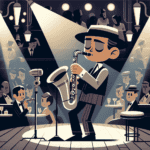Introduction
The clarinet boasts a colorful and varied past, with talented musicians pushing musical boundaries and cementing the instrument's place in jazz, classical, and modern genres. Clarinetists have shared their artistry with audiences around the globe, from lively New Orleans streets to Europe's grand concert halls. This article highlights some of the greatest clarinet players in history and their lasting impact on music.
Benny Goodman
Known as the “King of Swing,” Benny Goodman was a jazz clarinet pioneer. Born in Chicago in 1909, Goodman's fame soared in the 1930s with his big band, which became the face of the swing era. His unique blend of classical training and jazz improvisation created a captivating sound that drew in listeners.
Goodman's 1935 performance at the Palomar Ballroom was a game-changing moment for popular music, propelling swing into the mainstream. His hits like “Sing, Sing, Sing” and “Let's Dance” remain classics, inspiring musicians to this day. Goodman's clarinet mastery and innovative arrangements highlighted the instrument's flexibility and range.
| Clarinetist | Birth Year | Notable Contributions |
|---|---|---|
| Benny Goodman | 1909 | King of Swing, popularized jazz clarinet |
| Sidney Bechet | 1897 | Pioneered solo clarinet in jazz |
| Artie Shaw | 1910 | Innovative bandleader, blended classical and jazz |
| Johnny Dodds | 1892 | Early jazz pioneer, influenced by blues and ragtime |
| Woody Herman | 1913 | Versatile musician, led innovative big band |
Sidney Bechet
Sidney Bechet, a skilled clarinetist and soprano saxophonist, was known for his strong vibrato and emotive playing. He's often recognized as one of the first clarinetists to establish a prominent solo presence in jazz. Born in New Orleans in 1897, Bechet's unique sound was shaped by his environment, which included brass band music and blues.
Bechet's talent for expressing emotion through music made him stand out. His recordings, such as “Petite Fleur” and “Summertime,” showcase his melodic sensitivity and technical skill. He played a key role in bringing the clarinet to the forefront of jazz, and his improvisational abilities inspired many musicians.
Artie Shaw
Artie Shaw, another clarinet icon, continues to be celebrated for his contributions to jazz. Known for his charisma and innovative approach, Shaw was born in 1910 in New York City. He first gained recognition as a bandleader during the swing era, creating hits like “Begin the Beguine” and “Concerto for Clarinet.” His exceptional musicianship and incorporation of classical elements into jazz set his music apart.
Shaw's clarinet virtuosity shines through in his complex solos and intricate phrasing. He was among the first to integrate the clarinet into the big band format, making it a crucial part of his orchestration. Shaw wasn't just a talented performer; he was also an accomplished composer who significantly contributed to the growth of jazz music.
Johnny Dodds
Johnny Dodds has a special place in early jazz clarinet history. Born in 1892 in New Orleans, he played a crucial role in developing early jazz and is known for his work with King Oliver's Creole Jazz Band and Louis Armstrong. His playing style blended blues and ragtime elements, creating a unique sound that greatly influenced the jazz genre.
Dodds' ability to convey emotion through his playing and his frequent use of blue notes added depth to his music. His recordings, including “Doctor Jazz” and “Savoy Blues,” demonstrate his skill and are still admired by jazz enthusiasts. He's often seen as a bridge between traditional New Orleans jazz and the newer styles that followed.
Woody Herman
Woody Herman, born in 1913, is an important figure in jazz and clarinet history. He was not only a clarinetist but also a talented saxophonist and bandleader. Herman's big band, known as the “Herd,” was famous for its versatility and innovation. His unique orchestration and arrangements helped shape jazz in the late 20th century.
Herman's clarinet playing was characterized by its energy and enthusiasm. His recordings, such as “Woodchopper's Ball,” show his ability to blend improvisation with structured arrangements. Always pushing musical boundaries, Herman's contributions opened doors for future generations of musicians, helping keep the clarinet relevant in the ever-changing world of jazz.
The Role of Quality Instruments
These iconic clarinetists wouldn't have achieved their success without high-quality instruments. Brands like Martin Freres, known for their craftsmanship, have been crucial in shaping the sound of jazz clarinet. The careful attention to detail, choice of materials, and design of these instruments help artists in their quest for perfect tone and expression.
Good clarinets provide better projection and tonal clarity, allowing musicians to express themselves more freely. Investing in a well-crafted instrument can greatly improve a player's ability to achieve their desired sound, just as the best clarinetists in history did.
Whether you're inspired by Benny Goodman's swing or Sidney Bechet's melodic expressions, adopting the techniques and styles of these clarinet greats can help you develop your own musical voice. Learning from their legacy while appreciating quality craftsmanship can inspire your journey as a clarinetist.
Listen to their recordings, try out their techniques, and seize every chance to perform and collaborate with others. As you explore jazz clarinet, remember that you're writing your own musical story.







